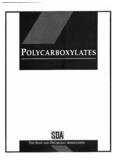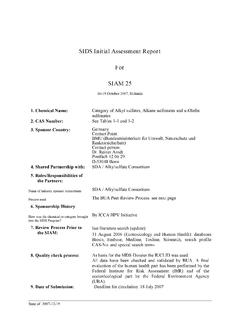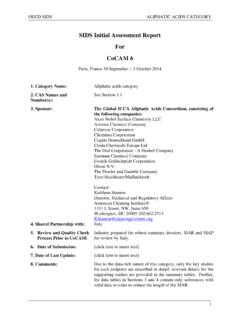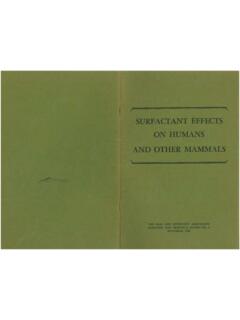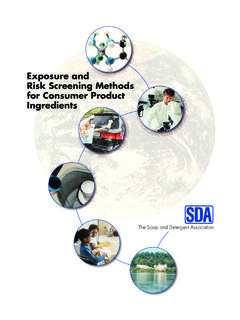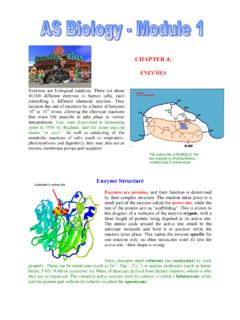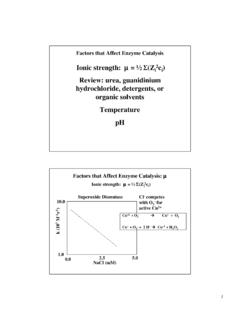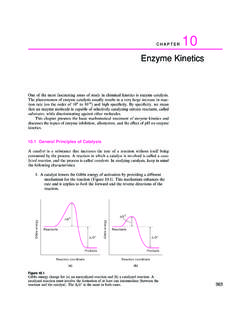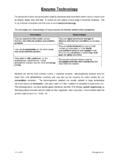Transcription of Risk Assessment Guidance for Enzyme-Containing Products
1 Risk Assessment Guidance for Enzyme-Containing Products The Soap and Detergent Association Table of Contents Preface 2. Executive Summary 3. Chapter 1 Introduction to enzymes 4. Chapter 2 Introduction to Risk Assessment 6. Chapter 3 Hazard Identification 8. Chapter 4 Dose-Response Assessment 11. Chapter 5 Exposure Assessment 17. Chapter 6 Risk Characterization 23. Chapter 7 Risk Management 28. Chapter 8 Conclusions 30. Bibliography 31. Glossary 38. Appendix 1 Estimation of Exposure to enzymes from Early Detergent Formulations 41. Appendix 2 Enzyme Risk Assessments of Hand-Laundering Practices 51. Appendix 3 Spray Pre-Treater Case Study 54. FIGURES 1, 2, 3 A, 3 B, 4 TABLE 1. Copyright 2005: The Soap and Detergent Association. Al rights reserved. No part of this document may be reproduced or transmitted in any form or by any means, electronic or mechanical, including photocopying, recording, or by any infor- mation storage retrieval system, without written permission from the publisher.
2 For information, contact: The Soap and Detergent Association, 1500 K Street, NW, Suite 300, Washington, DC 20005, USA. Telephone: +1-202-347-2900. Fax: +1-202-347-4110. Email: Web: PREFACE. For additional information on risk Assessment and T he laundry product industry has implemented a successful product stewardship program to promote the safe use of enzymes in the workplace risk practices for enzymes , contact your enzyme supplier, or and by users of their Products , using both appropriate risk Assessment and risk management practices. The Soap and Detergent Association Much of the information about enzymes for laundry 1500 K Street, NW, Suite 300. applications can be applied to other finished Products Washington, DC 20005. including those in the cleaning and personal care Tel: 202-347-2900. markets. e-mail: Web: This document provides Guidance on risk characteri- zation, that is, hazard identification, dose-response or Assessment , and exposure Assessment , in the develop- ment of new Products containing enzymes .
3 This infor- Enzyme Technical Association mation is used to develop an appropriate risk man- 1800 Massachusetts Avenue, NW. agement strategy that avoids unacceptable risks to Second Floor the user of Enzyme-Containing Products . It is not Washington, DC 20036. intended as a requirement nor a standard of care for Fax: 202-778-9100. manufacturers or the industry. The intended audiences for this document are toxicologists, risk assessors, and product safety professionals in industries formulating Products containing enzymes . The information presented here may not be entirely applicable to all situations where enzymes are used. Furthermore, certain conclusions are of limited certainty as detailed in the document. product manufacturers should consult individuals with appro- priate expertise in order to judge the applicability of this information, as well as information from other sources. 2. Executive Summary nzymes are proteins that speed (catalyze) reactions. The preferred approach as presented here is for prod- E They have the potential to improve efficiencies and provide previously unavailable product benefits.
4 Uct manufacturers to develop comprehensive pro- grams to assess and manage the risks of using In the last few years, the use of Enzyme-Containing enzymes in consumer Products . The program design Products has increased significantly and the number should be developed on a case-by-case basis to of applications in which enzymes are being incorpo- address parameters specific to the type of product rated is continuing to expand. enzymes generally and its applications. Key elements of this program have good safety profiles. However, enzymes , like include hazard identification, exposure Assessment , many other proteins, can act as allergens and induce and risk characterization. Good understanding of the production of allergen-specific IgE antibodies these areas will lead to informed decisions about the upon repeated inhalation or exposure to mucous potential risks and the development of sound membranes that may lead to allergy symptoms, approaches to manage these risks.
5 Including asthma. The cleaning product manufacturing industry's recent The purpose of this document is to describe the experience shows how successful implementation of potential health hazards of enzymes present in a product stewardship program, which includes consumer Products and provide a framework for appropriate risk Assessment and risk management manufacturers of these Products to conduct risk practices, helps to promote the continued safe use of assessments to help ensure the safety of new Products enzymes . Such practices can reduce the risk of acquir- containing enzymes . The primary challenge associat- ing enzyme allergies by workers and consumers. This ed with enzyme use is preventing the generation of document outlines strategies and methods that have allergen-specific antibodies and the development of been used successfully by the industry. symptoms of Type 1 hypersensitivity. This hazard is the primary focus for the risk Assessment for enzymes and must be managed carefully.
6 Another hazard that also should be addressed includes primary irritation of the eye and skin. However, most uses of enzymes in consumer Products do not pose a likelihood of causing irritation. Experience in the cleaning Products industry demon- strates that the potential risk of adverse effects can be successfully managed by identifying the hazards to be managed, carefully assessing exposure, characterizing the risk and then applying appropriate risk manage- ment. If the risks are not managed appropriately, the consequences may spread beyond a single prod- uct or company. This could lead to unwarranted limitations on the use of enzyme technology in other consumer applications. Therefore, it is recommended that companies using enzymes responsibly consider how they are managing enzyme safety including the conduct of appropriate risk assessments and risk management programs. 3. Chapter 1 Introduction to enzymes 1. WHAT ARE enzymes AND WHY DO WE 2. HOW DO enzymes WORK?
7 USE THEM? As discussed above, enzymes speed reactions that enzymes are proteins produced by all living organisms. usually occur at a much slower rate. The remarkable They act as catalysts to increase the rate of chemical property of enzymes is that they complete reactions reactions. They are generally named after the without being destroyed, allowing a single enzyme reactions they catalyze. Amylases catalyze reactions molecule to catalyze many individual reactions. with carbohydrates; cellulases react with cellulose; Therefore, they can be used at relatively low levels in lipases with lipids ( , fats and oils); and proteases consumer Products and still contribute to product with proteins. performance. The action of a model enzyme that breaks down substrate (the name used for a enzymes used in finished Products usually break substance upon which the enzyme is acting) is down certain materials into their basic components. shown in Figure 1. For instance, protease in laundry detergents breaks peptide bonds in proteins that make up food stains.
8 The first step in an enzymatic reaction is substrate Other ingredients in the product are able to remove binding to the enzyme at its active site. In this exam- the breakdown Products formed from the action of ple, a protein binds to the reactive site of a protease. enzymes easier than if the enzymes were not in the This portion of the enzyme is shaped specifically to product . In a totally different application, protease allow entrance of only certain substrates with the cor- enzymes might be formulated in skin care Products to responding shape, much like a key fits into a lock. If facilitate the removal of dry skin flakes (Kelling et al., the substrate does not fit the shape of the active site, 1998; Pocalyko et al., 2002). it cannot attach itself to the enzyme and no reaction occurs. In the figure to the right, the enzyme breaks down the substrate bound to the active site into smaller parts while the enzyme itself is unchanged. Once the enzyme breaks the substrate, the resulting Products are released from the enzyme.
9 Thus the enzyme reaction process can take place over and over as the enzyme repeatedly binds to more substrate molecules. Some other types of enzymes can bind two substrates at a time and catalyze a reaction to link the substrates together. Figure 1. How enzymes Work: the enzyme binds to a substrate and cleaves bonds, breaking the substrate into small components. 4. Chapter 1. Introduction to enzymes 3. HISTORICAL PERSPECTIVE OF ENZYME dustiness. With the introduction of encapsulated USE IN LAUNDRY Products enzymes and the implementation of improved han- dling procedures and manufacturing controls, the In the 1960s, dusty, non-encapsulated enzymes in incidence of respiratory allergy symptoms has disap- detergent manufacturing plants led to the production peared in consumers and has been greatly diminished of allergen-specific immunoglobulin E (IgE) antibod- in the workplace (Peters et al., 2000; Zachariae et al., ies and induced respiratory allergies among workers 1981; Schweigert, 2000; Pepys et al.)
10 , 1973; Pepys et al., (Flindt, 1969; Pepys et al., 1969). Furthermore, a few 1985). These observations provide compelling evi- sporadic cases of allergies were observed in con- dence that enzymes are safely managed for use in sumers and also in some women handling clothing of consumer Products . However, the use of enzymes in industrial workers containing dusty enzymes brought consumer Products is increasing in both the type of home for laundering (Zetterstrom, 1974; Belin et al., product and frequency of use. Good stewardship of 1970; and Bernstein, 1972). Since that time, solid enzymes involves accurate hazard characterization of enzymes have been encapsulated to reduce their Enzyme-Containing Products and proper risk assess- ment for both existing and new uses to prevent the development of allergy in workers and consumers. 5. Chapter 2 Introduction to Risk Assessment isk Assessment is the process of identifying the R hazard profile of a given material and gauging the likelihood of adverse effects occurring during han- 2.
